Calcio Storico Fiorentino a violent history lesson of Florence’s once gloried past

FLORENCE, Italy — The players march onto the sand-covered piazza behind a parade of troubadours, trumpet players, drummers and soldiers dressed in the pointy brass helmets of the Florentine Republic’s front-line army. Little boys dance and wave flags. The piazza floor fills with bright colors dominated by green and red. Green and red smoke spilling down from the grandstands on opposite sides of the piazza blocks out the light from the setting sun. Partially hidden in the mist, well-muscled Florentine men, half wearing green and the other half red, warm up like roosters before a cockfight. They fidget in the dirt, shadow box into a frothy sweat, zigzag between teammates, flag bearers and the occasional cameraman.
It’s the opening game of the 2015 Calcio Storico Fiorentino, a Florence tradition that dates back 500 years, back during the Italian Renaissance, when Florence was the biggest economic power in Italy, when art was its monetary unit and artists were its heroes. Yes, Florence. When you think of Florence, you think of the birthplace of the Renaissance, of Michelangelo masterpieces in the Uffizi, of the Ponte Vecchio straddling the Arno River at sunset. But hidden underneath the art, Chianti and romance is a sport that is all about blood, guts and a lot of glory. Calcio Storico Fiorentino combines rugby, soccer and violent assault. For nearly five centuries, Florence’s four major neighborhoods have gathered for one weekend in June and, literally, fight for a city they will risk facial rearrangement to defend.
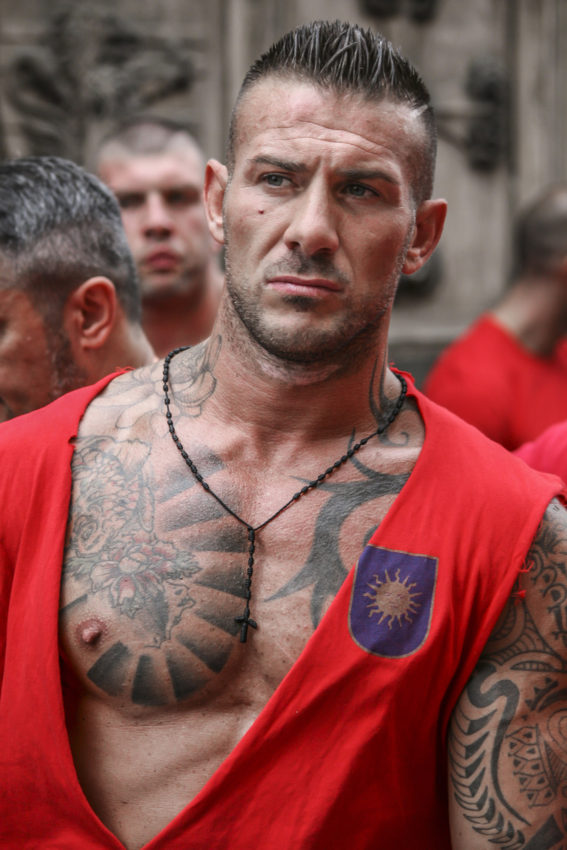
I intended to go last year. I heard bits and pieces about what many called the world’s most violent sport. I had to see for it myself. However, last year’s games were cancelled. Why? Because the sport had become TOO VIOLENT! Some rule changes brought it back. Also back are men with an extra year of pent-up hostility. I see the Red team, “I Rossi,” gather before the game in Piazza Santa Maria Novella, in northwest Florence and right in the heart of Reds territory. They are on the ground leaning against the Chiesa di Santa Maria Novella. All wear the traditional Florentine Republic pants that are baggy, multi-striped and look like they were torn off court jesters. These guys, however, are not laughing. They are all heavily muscled and tattooed to where I see more ink than skin. Their hair is already glistening with sweat and water from bottles they keep splashing to cool their jets.
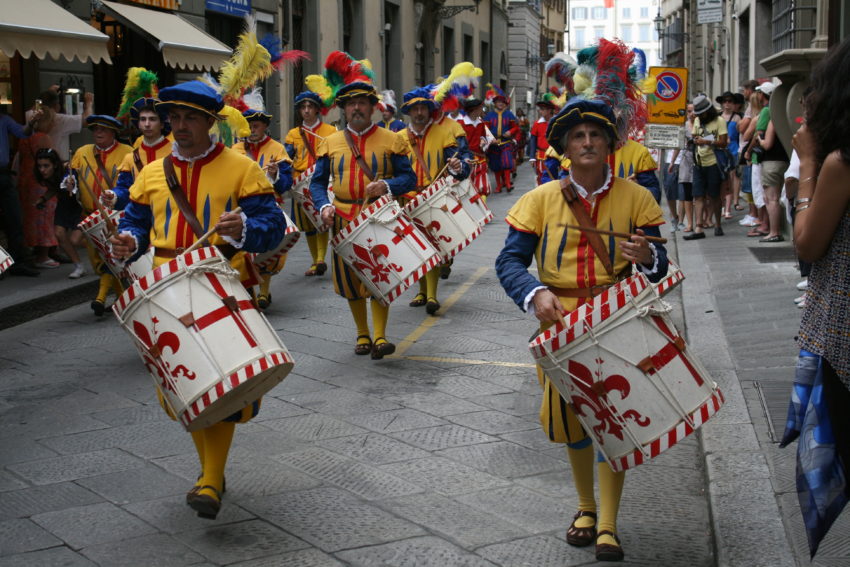
While the Reds are from the neighborhood of Santa Maria Novella, they play the Greens from San Giovanni, in central Florence surrounding the famous Duomo. The Whites are from Santo Spirito on the other side of the Arno in the southwest and the Blues, whom the Whites play the next day, are from Santa Croce in the southeast. Florence neighborhoods have no demarcation lines. Florence is not South-Central L.A. Yet the four ‘hoods have been at war for 500 years.
I ask the manager of the Reds, Rodolfo Carbone, a burly 50ish fellow with short gray hair and beard, what this event means to the Florentine people. I want to ask why normally sane men beat the brain cells out of each other every year in a city small enough to see each other every day. However, one of his players stands my height, 6-foot-3, and his tattooed-chest can fit a family of four.
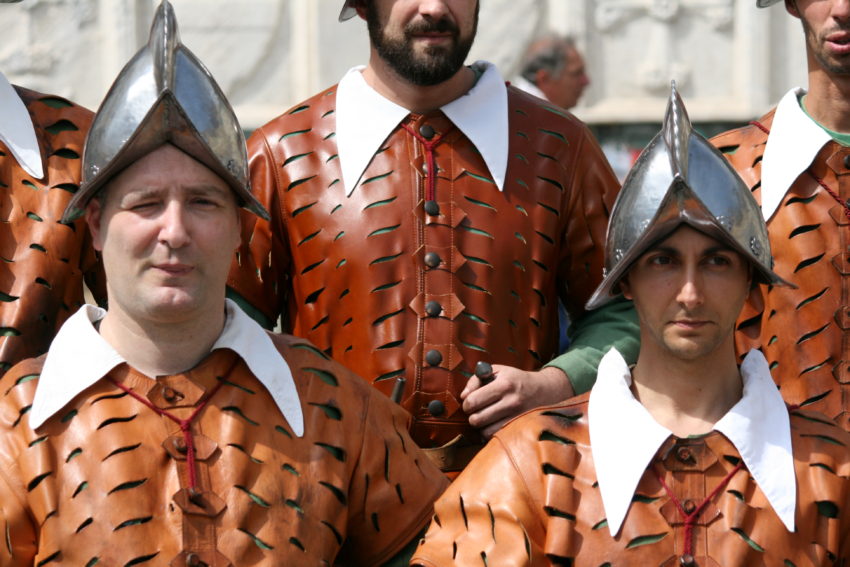
“You’re born with this,” says Carbone, an import-exporter, tapping his heart. “You have it inside you since you were a child. When you start doing it, you feel something. You feel something to be Florentine.”

I follow the parade as it snakes its way through the streets of Florence to the piazza. The drummers lead the way, pounding a steady “BOOM! BOOM! BOOMBOOMBOOM! BOOM! BOOM! BOOMBOOMBOOM!” With the hulking, frowning players slowly marching behind, it sounds like a march to the gallows. Yet the trappings of 21st century Florence stand in deep contrast to this 16th century tradition. Something about a bald, sweating, bare-chested man covered in tattoos walking past a Max Mara store jars you back to the present. Yet if you have a good imagination, you can picture this procession passing blacksmiths and cobblers and donkeys during the Renaissance. Maybe Michelangelo put down his chisel to stare at the men.
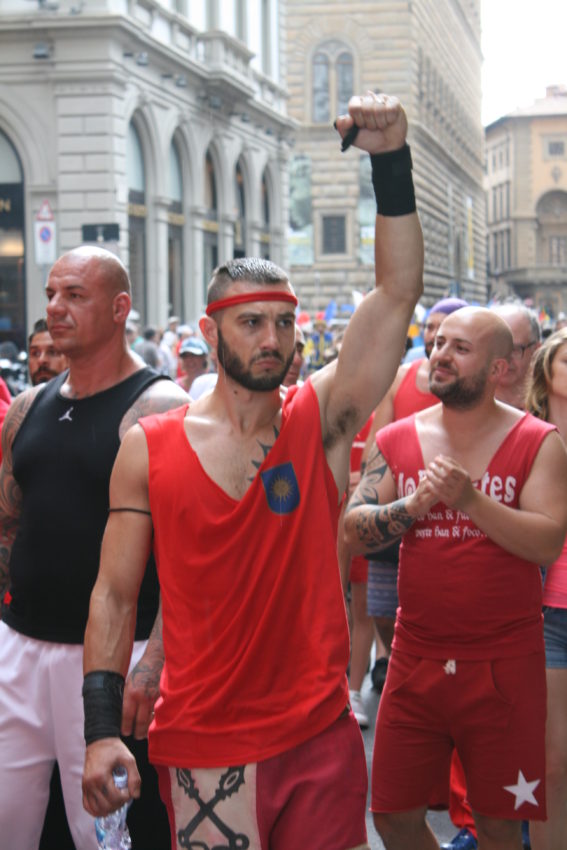
The parade marches an hour before it enters Piazza di Santa Croce. Hovering over one end is the towering black and white Basilica di Santa Croce which houses the corpses of such famous Florentines as Michelangelo, Galileo and Machiavelli. A statue of Dante Alighieri, perhaps Italy’s most famous author, has a perfect view of the field from the front of the basilica. How ironic his image spends an eternity watching this event after he wrote one of my favorite books, “Inferno.”
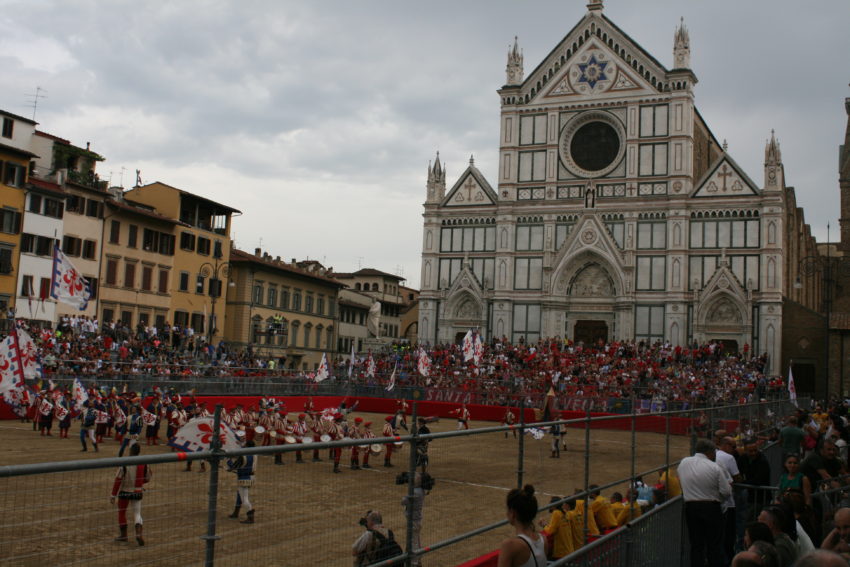
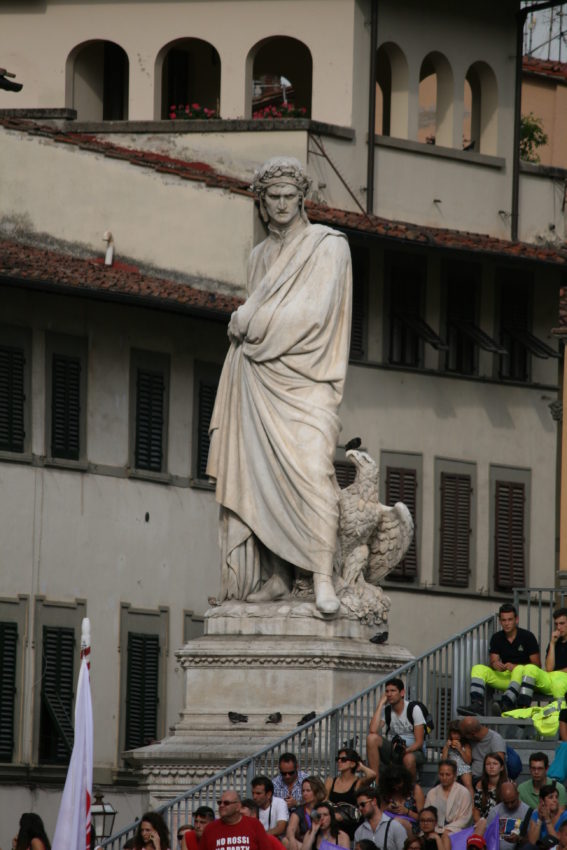
The field is heating up into what I’m told will be a living hell. The trumpeters leave. The children escape. All that’s left are 54 men, 27 to a side, their shirts long gone and sweat covering their bodies. Teammates hug and pound each other in a football-style warm-up drill. Everyone is shadow boxing. As the public announcer screams “VIVE FIRENZE!” a bearded player in green drops his head back, closes his eyes, slightly opens his mouth and clenches his slightly raised fists, seemingly in a trance. I try to find a vantage point to shoot photos through the Cyclone fence. I couldn’t help noticing how much it resembles a cage from an MMA card. But MMA doesn’t have much on this.
Soon, both sides stand on their side of the field. Opponents lock eyes. A referee called a Pallaio, in a baggy, florid outfit, holds a ball aloft. A whistle blows, the ball goes in the air and …
***
The year was 1529. Florence was the center of the Italian Renaissance. Michelangelo completed David, today still the world’s greatest sculpture, in 1503. Eight years later he would finish painting the ceiling of the Sistine Chapel. The Florentine Republic, established in 1115, was the greatest economy power on the Italian peninsula for 200 years. However, in 1530 Charles V, a Spaniard who was emperor of the Holy Roman Empire, sought favors from Pope Clement VII and in October 1529 attacked Florence, which had clashed with the pope and wanted to stay independent.
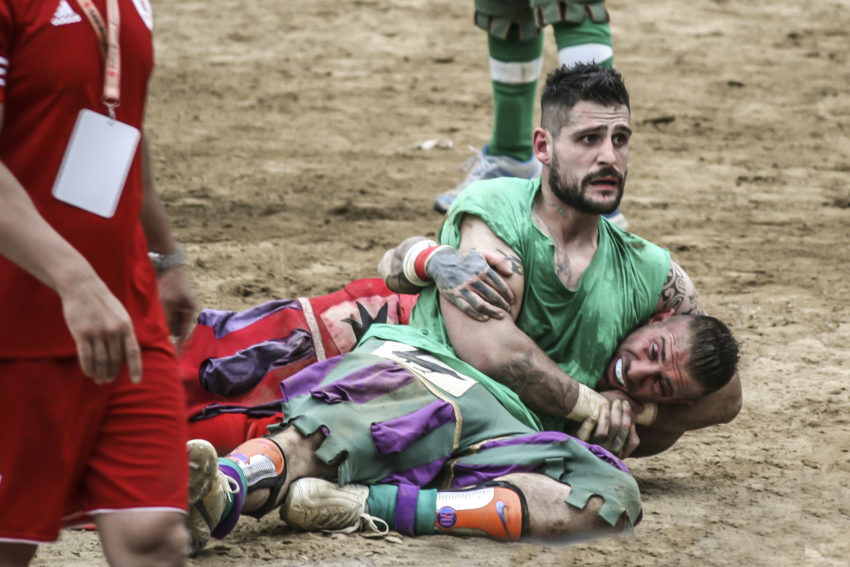
A siege lasted 10 months. In what amounted to a major rattling of sabers, the Florentine citizenry put on a show of their own. The four major neighborhoods met in June 1530 in a bare fisted brawl in Piazza di Santa Croce to show Charles V they weren’t scared of his army, that they were tough enough to handle any siege.
Alessandro Ghidoli, 56, is heavily into Calcio Fiorentino. A Florence resident since 1979 and a son of a native Florentine, Ghidoli joins the parade as an Archibusieri, one of the Florentine soldiers. He’s as much of an objective historian as you’ll find. I ask him why they still do this after 500 years.
“It’s a remembrance, although a bit peculiar, of a historical moment when Florence showed all its power, pride, importance in a political competition all around Europe,” he says. “This is at the same time the strength and the problem with the Calcio Storico. The strength because all around the years during the centuries, it comes out the pride of the Florentines, who are very particular and individuals, very proud.
“At the same time is the problem because it’s not a game. It’s only a history of violence.”
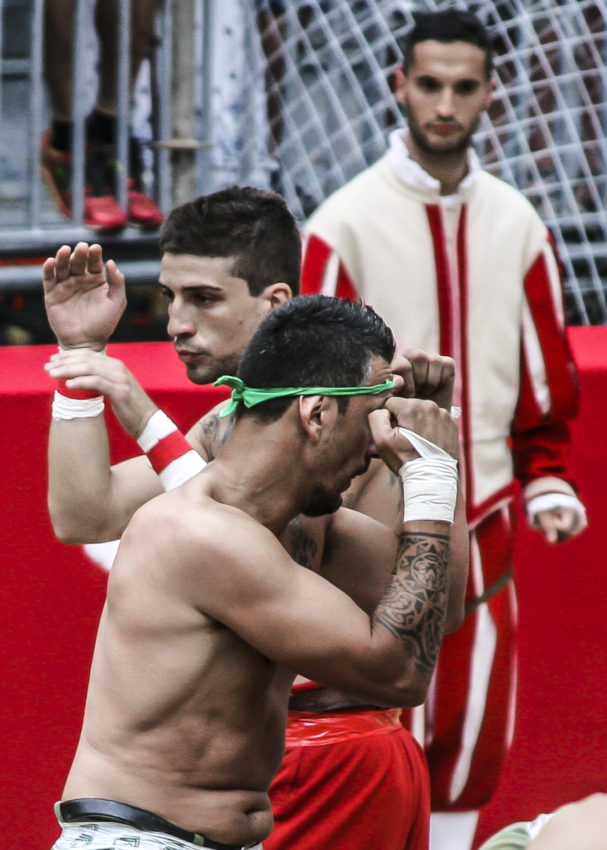
The problem of the Calcio Storico is the essence of what inspired it: violence. The rules are simple. There are 27 men to a side. Teams try to advance a ball about the size of a soccer ball up a field that’s 80 meters long and 40 wide. To score they must move the ball upfield and put it behind a padded cushion that stretches the length of the opponent’s end. That’s worth one point. The space between the cushion and fence is about a meter wide. If a player tries to throw it in the opening and instead hits the fence behind it, it’s a half point for the other team.
As far as defense, well, anything goes just short of cutlery. Fighting isn’t just allowed, it’s expected. So is kicking. So is tackling the head. Neighborhoods’ thirst for winning reached a point where they reached across the water for talent. They tapped Ireland and Great Britain for hired thugs and rugby ringers. The games became so violent, the ball became mere decoration in a landscape of fistfights. No deaths have occurred but men have been hospitalized for up to five months with head injuries. They cancelled it all in 2014 then brought it back with some subtle rule changes: Players must be Florence residents for at least 10 years. Multiple men can’t fight one opponent, unlike before when gang beatings were common. If a player is disqualified and doesn’t leave the field within three minutes, his team is disqualified.

Even Ghidoli tells me, “This is not sport. First, at the basis of sport there is fair play. No? Or in the (Baron de) Coubertin (who wrote the Olympic Oath) way, the importance is not to win always but to participate. In Calcio Storico, those two rules are nothing. You have ONLY to win in whichever way and it’s not a fair game.”
Yet the games go on. Florentines stick out their chests, wear their colors, fire their smoke bombs and wave their banners. Lost in what Calcio Fiorentino has become is this: Maybe modern Florence should take a history lesson. How much did these games scare Charles V in 1530?
In what forevermore would be called the Siege of Florence, the city surrendered that August.
***
… five fistfights immediately break out. Ten men square off on a sand floor, fists up, feet shuffling, jabs throwing, testing their opponent. This isn’t a bar brawl. These are chiseled, mostly tattooed men with decent boxing skills. Curiously, I see they’re facing opponents about their size as if Calcio Storico has weight classes. I focus my camera’s zoom lens on one pair and my trigger finger is too late. POW! A right cross from a Green hits a Red square in the face. He goes down. The medic team gets up. Men in yellow fluorescent uniforms carry a stretcher to the man prone on the ground. He is not moving. The other men are. They’re all still boxing. They’re in various states of clutching, feigning, punching and holding. Two have opponents in immovable positions, like wrestlers ready for a pin.

Meanwhile, behind the line of unarmed gladiators, four guys from the red team pass the ball around underhanded, unguarded. That’s all they do. They just pass it back and forth like little kids at a beach. They have no more interest in advancing the ball than they do advancing mankind. The Green defenders by their goal stand back and watch. It’s absurd to the point of hilarity. Completely forgetting my Italian, I yell to no one in particular, “THIS IS NOT SPORT! THIS IS RIDICULOUS!”
The violence gets worse as the game heats up. A Red player appears to beat up a Green and a Green teammate comes to the rescue. He appears to kick the Red in the head. A referee dressed in what in some rural American towns would consider a clown outfit, gives him the thumb. It isn’t for kicking him in the head; it’s for jumping in as a third party. New rule, you know.
After 12 minutes, the Green team finally gets the ball. But the blockers seem more interested in fighting than blocking. A Green picks up a Red and body slams him to the dirt to a hearty cry of “OOOH” from both sides of the piazza. Nearby, a Red pounds a Green into the ground and a Green gets a running start and lands a perfect right foot into his skull. The Red’s grip suddenly loosens and he slowly rolls onto his back, seemingly out cold. He is not. Soon he’s up and fighting again.
Meanwhile, the Red team knocks the ball loose — I don’t know. I long ago realize the ball is a meaningless prop. Maybe someone tore off a ball carrier’s right arm. — and has a clear path up the left side of the piazza. He does not run. This whole affair reminds me of a hockey match between two teams who had a score to settle from the drop of the puck. Except this score has lasted two years.
“Generally, the first 10 minutes of the game is a show of strength: ‘We are ready to fight,’” Guidoli tells me later.
Soon I see 10 pairs on the ground in various holds. That’s 20 players not doing anything. There is no time limit on letting up the opponent. One time, two players are on the ground in their own vice. One leans out, grabs it, gives it a weak push to a teammate and resumes clutching his opponent as if he’s saying, “Oh, yes. There’s a ball. I’m supposed to do something with it but I can’t recall what.” One guy, straddling another’s chest, appears to have a normal conversation with him, like they’re discussing the best places for bistecca fiorentina.
Finally, like the captain of the Titanic who has long been forgotten, the ball reappears. A Green player gets near the Red goal and throws it at the opening behind the red padding. Nope. It hits the fence. Penalty half point. It’s Reds ½, Greens 0. Twenty-five minutes of the 50-minute game have passed. This would be halftime but there is no halftime. There are no breaks, no timeouts. The only subs come for injuries.
The ball is thrown into the middle of the field again. It’s batted around and bounces along the dirt. There is no mad dash of rabid humanity trying to recover it. This isn’t American football. It’s Calcio Fiorentino and more fights break out. Now I start looking at my watch. I’m getting bored with flying leg kicks, body slams, skulls getting knocked back only to return with a grin behind a mouth guard and curling fingers to say, “Come on! Is that all ya’ got?”
In the second “half,” the Greens get serious. One races down the left side of the piazza for one goal, a Red throws too high on another. The Greens go ahead 2 ½-½, the Reds tie it with five minutes left and the Greens win a minute later with a mad solo dash upfield that would be worthy of American football athleticism if not for the eight pairs of fighters on the ground at the time.
If this is sport, house painting is art. I see little athleticism. No one is terribly fast or quick. I see no moves. The boxing is skilled but slow and methodical. They are fit, big and mean. They are also crazy. They are putting themselves at this kind of risk for a tradition that dates back to the time when their city’s most famous period in your history fell to a power-hungry Spanish asshole.
As the whistle blows, the Reds fall in despair. The Greens fall kissing the dirt. Green-clad fans, many with quite large breasts, pour onto the ground to hug the players. I manage to reach the sideline where I ask a balding, muscular Green player named Mirko Cardelli why he does this.
“When you are born in Florence, you have it in your blood,” says Cardelli, a trained boxer who was in his 13th game and delivers food to the sick in a hospital. “I have a lot of competitive spirit. To me, this is sport. I don’t hate anybody.”
The players say rivalries don’t spill into the streets. Florence is not a big city. It has only 380,000 people. Daniele Brumillotti runs a bar called Chocolate. He’s 43. This is his 25th game. He’s also the player who got tossed for kicking the guy in the head of which he tells me, “But I didn’t do anything!”
I ask him if he hates the other neighborhoods.
“I love Florence and am very proud to be Florentine,” says Blumillotti whose team plays the Whites, the current Calcio Storico power, in Wednesday’s final. “It’s why I practice Calcio Storico. I hate my rivals. But only on the field. When we meet in the city, everyone’s my friend.”
I understand the historical significance and Italians holding their history close to their vests. I trained for two months with Rome’s gladiator school. From what I read, the Ancient Romans’ were mankind’s first Nazis. I later died in a reenactment of a gladiator battle in front of about 1,000 tourists in a colosseum outside Rome. I get it. But that was a reenactment. I was even chastised for playing dead on the colosseum floor while furiously trying to pull my one-size-fits-all tunic over my underwear. Calcio Storico, however, is a full-scale brawl with more incentive to score the most blows than the most goals.
Charles V wasn’t impressed and, frankly, neither am I.

